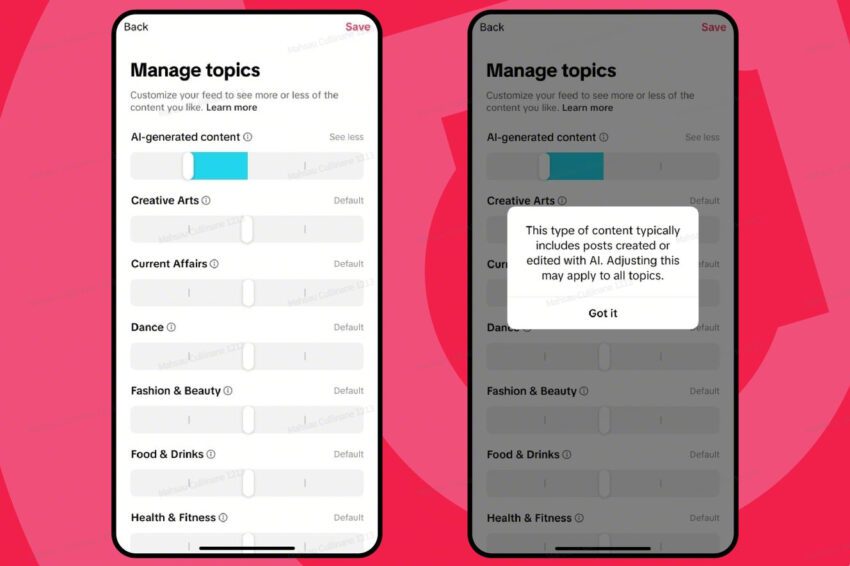
tiktok is letting users control how much TikTok is introducing a new feature that allows users to control the amount of AI-generated content they encounter in their feeds.
tiktok is letting users control how much
Overview of the New Feature
TikTok is currently testing a feature that provides users with the ability to manage the visibility of AI-generated content in their video feeds. This new control will be integrated alongside existing content management options under the “Manage topics” section of the app. Users will be able to adjust their preferences for various content categories, including dance, current affairs, and fitness, and now, they will also have the option to manage the amount of AI content they see.
Functionality of the AI Slider
The AI control will function similarly to the existing sliders that allow users to specify their interests in different content areas. Users will have two levels of control in either direction, enabling them to request to see more or less AI-generated material. This feature aims to enhance user experience by providing more personalized content, allowing individuals to curate their feeds according to their preferences.
Importance of Content Detection
For the AI slider to function effectively, TikTok must first identify which content is generated by AI. This necessitates improvements in the platform’s content detection capabilities. TikTok is aware that users often remove visible watermarks from AI-generated content, which complicates the identification process. To address this issue, the company plans to implement invisible watermarks on content created using its AI tools, such as AI Editor Pro. This step is crucial for maintaining the integrity of the content identification process.
Implementation of Invisible Watermarks
In addition to the AI slider, TikTok will introduce invisible watermarks on videos created with its AI tools. These watermarks will help the platform recognize AI-generated content more reliably. The use of invisible watermarks is part of a broader strategy to ensure that users can differentiate between human-created and AI-generated content without compromising the aesthetic of the videos.
Industry Standards and C2PA Content Credentials
Moreover, TikTok will also support videos uploaded with C2PA Content Credentials, an industry-wide authentication standard designed to verify the authenticity of digital content. This standard aims to combat misinformation and enhance trust in the content shared across platforms. However, it is worth noting that the C2PA standard has already faced challenges in its implementation, raising questions about its effectiveness in the long run.
Timeline for Rollout
TikTok has announced that both the AI slider and the invisible watermark features will be rolled out over the coming weeks. However, it is essential to clarify that the AI content control is currently in the testing phase, meaning that its availability may vary among users. The company has not specified a definitive timeline for when the feature will be fully operational for all users.
Context and Implications of AI Content Control
The introduction of AI content controls comes at a time when concerns about the proliferation of AI-generated material are growing. As AI technology continues to evolve, the line between human-created and machine-generated content is becoming increasingly blurred. Users are expressing a desire for more control over the content they consume, particularly as AI-generated content becomes more prevalent across social media platforms.
User Concerns and Preferences
Many users have voiced concerns regarding the authenticity and reliability of AI-generated content. The ability to filter AI content allows users to curate their feeds more effectively, ensuring that they engage with content that aligns with their interests and values. This feature is particularly relevant in an era where misinformation can spread rapidly, and users are seeking ways to verify the authenticity of the information they encounter.
Stakeholder Reactions
The response from stakeholders, including content creators and industry experts, has been mixed. Some content creators welcome the opportunity to utilize AI tools to enhance their videos, while others are concerned about the potential oversaturation of AI-generated content on the platform. Industry experts emphasize the importance of transparency in AI-generated content, advocating for clear labeling and identification to maintain user trust.
Future of AI in Social Media
The introduction of AI content controls on TikTok is a significant step in the ongoing conversation about the role of AI in social media. As platforms continue to integrate AI technology into their services, the need for user control and transparency will become increasingly important. TikTok’s initiative may set a precedent for other social media platforms to follow, as they navigate the complexities of AI-generated content.
Potential Challenges Ahead
Despite the positive aspects of the AI slider and invisible watermark features, challenges remain. The effectiveness of the content detection system will be crucial in determining how well the AI slider functions. If TikTok cannot accurately identify AI-generated content, the feature may fail to meet user expectations. Additionally, the implementation of invisible watermarks may face scrutiny from users who prioritize privacy and may view such measures as intrusive.
Broader Industry Implications
The introduction of these features also raises questions about the broader implications for the social media landscape. As more platforms adopt similar measures, there may be a shift in how users interact with AI-generated content. This could lead to a greater emphasis on authenticity and trustworthiness, prompting platforms to invest further in content verification technologies.
Conclusion
TikTok’s new AI content control feature represents a proactive approach to addressing user concerns about AI-generated material. By allowing users to manage their exposure to AI content and implementing invisible watermarks for better detection, TikTok is taking significant steps toward enhancing user experience and trust. As the feature continues to be tested and refined, it will be interesting to observe how users respond and how it influences the broader social media landscape.
Source: Original report
Was this helpful?
Last Modified: November 19, 2025 at 11:37 pm
0 views















